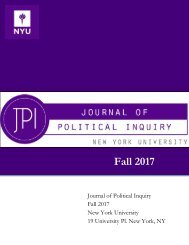Fall2016_Final
You also want an ePaper? Increase the reach of your titles
YUMPU automatically turns print PDFs into web optimized ePapers that Google loves.
series of bilateral measures gained momentum during the 1980s and culminated in the creation of the<br />
ABACC. This agreement proved to be a better alternative because each country wanted to assure the<br />
world of the peaceful nature of its nuclear program. Another remarkable feature of the ABACC system<br />
was the inclusion of nuclear inspectors from both Argentina and Brazil. Because nuclear arms control<br />
and verification are of serious concern to national security, countries undergoing inspections typically<br />
demand a certain degree of involvement in the process. 33 This was an inherent advantage of the<br />
bilateral nonproliferation regime because it was tailored to Argentina’s and Brazil’s preference for joint<br />
inspection, an advantage that international nonproliferation regimes (such as the NPT) had not<br />
previously been able to offer.<br />
THE INDIAN-PAKISTANI NUCLEAR CONFLICT: HISTORY, NUCLEAR<br />
DOCTRINE AND NONPROLIFERATION POLICY<br />
Unlike South America, where the nuclear rivalry between Argentina and Brazil did not cross<br />
into a weapons threshold, the bilateral nuclear competition in South Asia is more severe because it<br />
involves two nuclear-armed states, India and Pakistan. The persistence of armed conflict in, and the<br />
territorial dispute over, the region of Jammu and Kashmir makes nuclear proliferation in South Asia<br />
a serious cause for concern for the international community, and provides a raison d'être for India’s and<br />
Pakistan’s nuclear weapons. India and Pakistan are able to operate a full nuclear fuel cycle. 34 It is<br />
estimated that the number of warheads in India’s possession ranges from 90 to 110, while the quantity<br />
of Pakistan’s warheads is between 100 and 120. 35<br />
THE DEVELOPMENT OF THE INDIAN-PAKISTANI NUCLEAR ARMS RACE<br />
Soon after gaining independence from Britain, India started developing a peaceful nuclear<br />
energy program. However, conflicts between India and Pakistan-backed guerilla forces to gain<br />
sovereignty over Kashmir in 1947, several border clashes with China in the 1960s, and domestic<br />
political support for nuclear deterrence stimulated India’s interest in conducting a nuclear explosion.<br />
In an effort to demonstrate its nuclear capability, India exploded an atomic device under the guise of<br />
a peaceful nuclear explosion in May 1974. 36 Fearing India’s conventional forces’ superiority and<br />
nuclear advancement, Pakistan reciprocated by accelerating its own nuclear weapons program, to the<br />
point of enduring economic hardship. 37 With China’s assistance and cooperation from Abdul Qadeer<br />
Khan, Pakistan managed to acquire the means to produce highly enriched uranium in order to<br />
weaponize its nuclear program. 38<br />
1998 marked a milestone in South Asia’s proliferation history. In May, India tested five nuclear<br />
weapons and, to demonstrate its deterrence capability, Pakistan responded by detonating six nuclear<br />
bombs. 39 Since then, both governments have adopted “credible minimum deterrence” and have<br />
33<br />
Arian L. Pregenzer, Michael Vannoni and Kent L. Biringer. “Cooperative Monitoring of Regional Security Agreements” (Nonproliferation and Arms<br />
Control Analysis Department, 1996), 21 http://www.sandia.gov/cooperative-monitoring-center/_assets/documents/sand96-1121.pdf.<br />
34<br />
“Country Profiles – India – Nuclear,” Nuclear Threat Initiative, accessed May 15, 2016, http://www.nti.org/learn/countries/india/nuclear/. “Country<br />
Profiles – Pakistan – Nuclear,” Nuclear Threat Initiative, accessed May 15, 2016, http://www.nti.org/learn/countries/pakistan/nuclear/.<br />
35<br />
SIPRI Yearbook 2015: Armaments, Disarmament and International Security – Summary (Solna, Sweden: Stockholm International Peace Research Institute,<br />
2015), 18, accessed October 17, 2016, https://www.sipri.org/sites/default/files/2016-03/YB-15-Summary-EN.pdf.<br />
36<br />
“Country Profiles – India – Nuclear,” Nuclear Threat Initiative, accessed May 15, 2016, http://www.nti.org/learn/countries/india/nuclear/.<br />
37<br />
In 1965, Pakistani President Zulfika Ali Bhutto stated: “if India builds the bomb, we will eat grass or leaves, even go hungry, but we will get one of<br />
our own.”<br />
“Country Profiles – Pakistan – Nuclear,” Nuclear Threat Initiative, accessed May 15, 2016, http://www.nti.org/learn/countries/pakistan/nuclear/.<br />
38<br />
Abdul Qadeer Khan’s network specialized in illicit nuclear trade and helped countries evade Western restrictions on the export of nuclear<br />
technology.<br />
“Country Profiles – Pakistan – Nuclear,” Nuclear Threat Initiative, accessed May 15, 2016, http://www.nti.org/learn/countries/pakistan/nuclear/.<br />
39<br />
Ibid.<br />
Journal of Political Inquiry | Fall 2016 | 8
















